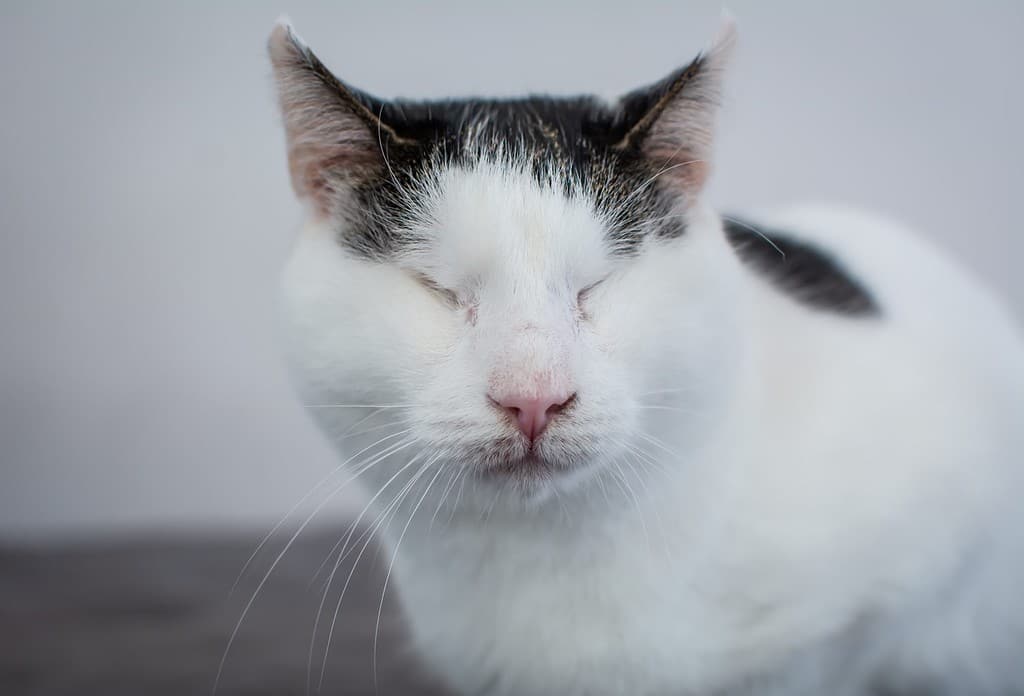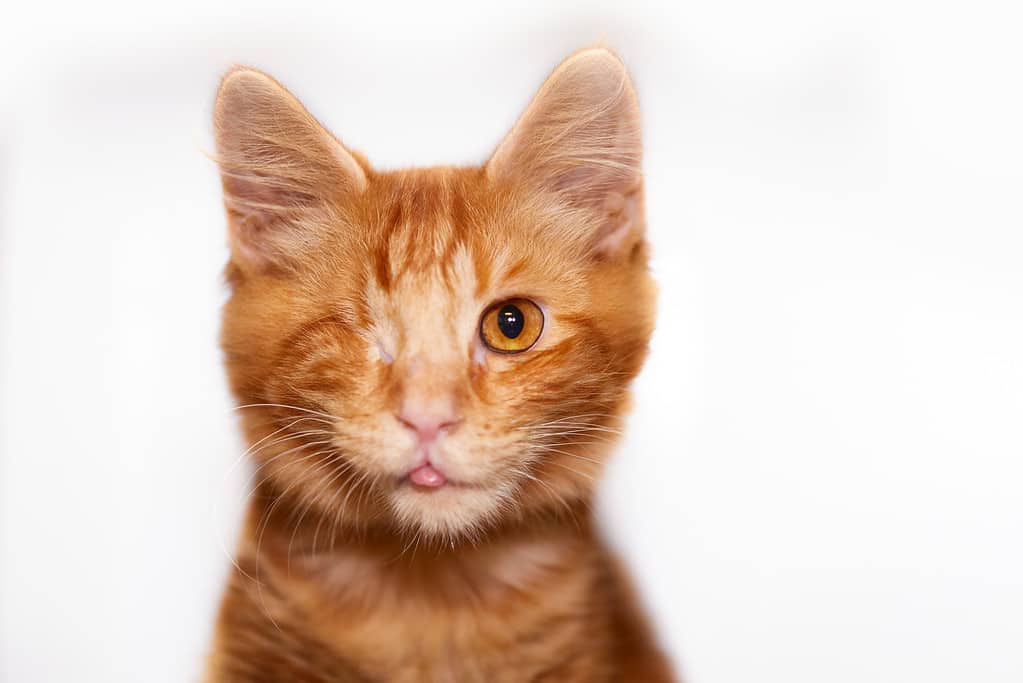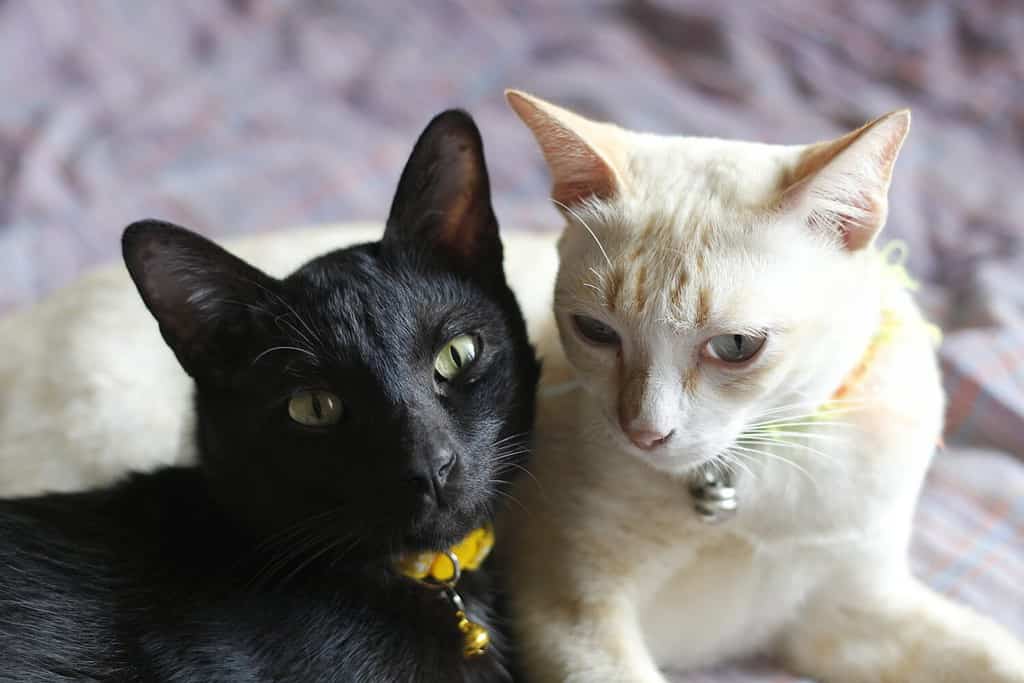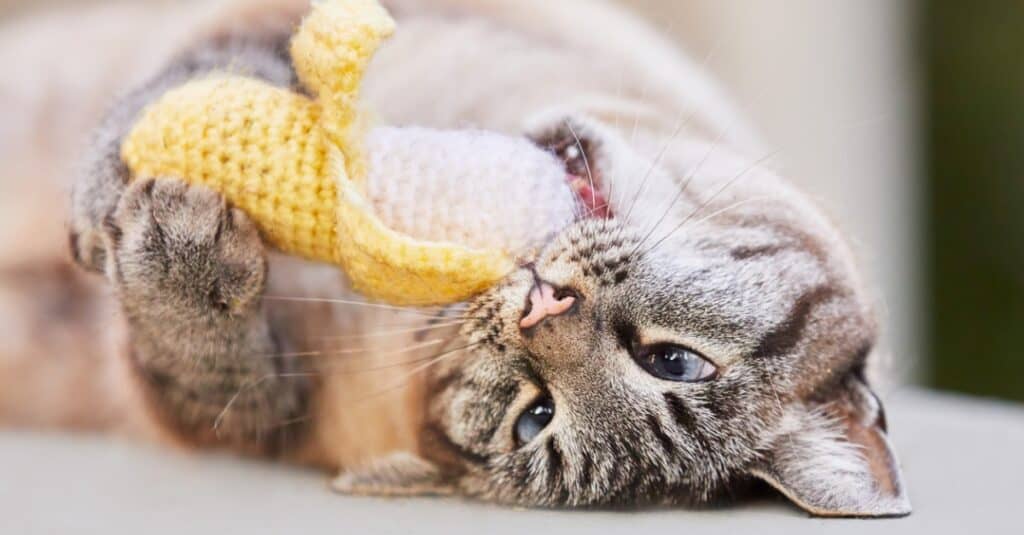Having a cat or a few cats can be an extremely rewarding experience for all lives involved. Bringing home a visually handicapped cat is a wonderful choice for an overlooked cat that might not have much hope when overlooked for those without any visual impairment. Many times, a one-eyed cat has very little handicap and can shoot through the air and catch a fly just the same as its two-eyed rivals. This isn’t always the case. Some cats might have more severe visual impairment and have only slight vision or be completely blind. Like all felines, those cats will own the handicap like a boss, but they could use a little help from their humans to make life a little bit easier. This article will take a look at visually impaired cats and ways to make their lives easier. After all, we all need a little help from time to time.
The Dilemmas of the Visually Impaired Cat

Cats can lose their vision in many ways.
©Paulina Grzybowska/Shutterstock.com
If you have chosen to rescue a stray visually impaired cat, you likely wonder how they came to have such a severe injury. Many stray cats face hardships without a home, and some hardships can include fighting with other cats over food or territory. This is especially true for male unaltered cats. Most neutered male cats do not fight because their testosterone is lower, resulting in a calmer cat without the need to fight with other males.
Other times, partial or total vision loss can arise from viruses with cold-like symptoms. Oftentimes, cats experiencing such symptoms will end up with gunky crusty eyes from the virus. They use their paws to run at their eyes, which can easily cause a significant enough injury to rupture the eye, which causes vision loss. Many cats with severe infections have their eyes removed to prevent further infection.
Some Ways to Make Their Lives Easier

Pirate kitties are some of the cutest out there.
©Svetlana Popova/iStock via Getty Images
The best way to figure out how to make your visually impaired cat’s life easier is to be empathetic to their circumstances. What would make your life easier if you were visually impaired? Probably finding the important places like the bathroom, refrigerator, buttons on the microwave or oven, and doorways, to name a few. Think like your cat might. What are the most important daily needs? What would be difficult to navigate? A completely blind cat will shock you with the mischief they can still get into.
1. Make Important Places Easy to Find
One of the most important ways to help your visually impaired cat is to make their food, water, and litter box easy to find and use. Pick a permanent place for each item and make entering the litterbox easy. A high-sided one with a low front entrance works well. Placing the litterbox in a corner works well. Your cat will do well with their food and water bowls near each other but not right against one another. Eating can be a bit messier with a visually impaired cat. Leaving their items in one place is important to avoid confusion and accidents. Try placing the bowls on a mat for easy locating.
2. Understand Your Cat Will Use Their Claws More
Your cat will do a lot more climbing than jumping. This can be difficult if you do not have covers on your furniture. It’s simple to find sturdy couch and chair covers online. Your cat will climb onto the couch using their claws to pull themselves up. Over time, this can do a number on your furniture. This is also true with your bed. It’s possible to save your bedding by placing a sturdy comforter or other blanket that you don’t mind getting messed up over your bedding. There are also stairs and ramps for furniture or beds, but ensure the sides won’t let your cat fall.
3. Get Used to Not Moving Things Around

This tactile ground surface indicator for blind and visually impaired people helps them navigate busy streets.
©Torjrtrx/iStock via Getty Images
One of the most important rules to remember when living with a visually impaired cat is not to move things around or place unexpected items on their level. This is especially true for blind cats. Depending on the level of visual impairment your cat has, it’s possible that rearranging your home will have little effect on them. Use your best judgment. If your blind or almost blind cat needs to remember where a piece of furniture is or is, you must put something new in the line of their travel; consider placing markers around it so your cat slows down and realizes something is in their way. This can be accomplished in many creative ways. For visually impaired or blind people, bump strips are used to create safe paths. With your cat, you might use something similar approximately a foot away from the item’s perimeter.
4. Helping Your Cat Know Which Cat/Dog is Approaching

Collars with bells provide an inexpensive way for your blind cat to distinguish one cat from the other at a distance.
©Wasuta23/Shutterstock.com
This is a nice way to help your blind or severely visually impaired cats from knowing whose paws they hear approaching them. If you are a multi-cat or dog household, choose bells that sound different and place them on each animal’s collar. Your blind cat does not need a bell. They will quickly figure out which cat or dog belongs with which bell. It’s also a good idea to have anyone who visits speak with your cat and talk to them when they are approaching so the kitty doesn’t get confused.
5. Let Them Explore
It can be nerve-racking when you first bring home a visually impaired or blind cat. It can be challenging when trying to figure out the dos and don’ts of living with your new friend. The best thing you can do is to let them explore on their own terms. Of course, you should follow along to show them the best ways to climb onto things and coach them while they meander. They will surprise you by how quickly they become accustomed to everything, especially navigation. Make sure to make your space visually impaired and cat-friendly, and block off any areas or rooms with extra obstacles. They have long whiskers to help them know when an object is closing in.
6. Play with Them

Cats all love toys!
©iStock.com/Svetlana Popova
Your visually impaired cat will appreciate toys just the same as any cat. Choose toys with catnip, rattles, or other noise makers. They might even play fetch with you. Obviously, laser pointers and anything solely based on visual stimulation will not work with a blind cat but can be just fine for cats with varying levels of visual impairment. Cats love to play, and if you have more than one cat, they will play together and tackle one another before you know it. Make sure to play with your cat every day, and they will look forward to it.
7. Don’t Worry!

Most cats love affection on their terms.
©Kristi Blokhin/Shutterstock.com
It’s hard not to worry when you have a pet with a handicap. Regarding cats and their ability to handle their handicaps with very little concern, we sometimes need a reminder to relax. Don’t be a “helicopter cat parent” and constantly control what your cat does or doesn’t do. They need their freedom to explore and play. Be sure to block off the railing on stairs and take care of any red flags throughout your home, then let them figure it out. Cats are incredibly resilient and have a way of always making the best of their situations. Blindness or visual impairment is not going to slow them down. Support their adventurous side and let them be cats.
The photo featured at the top of this post is © eAlisa/iStock via Getty Images
Thank you for reading! Have some feedback for us? Contact the AZ Animals editorial team.







